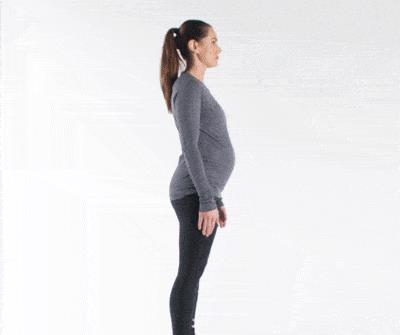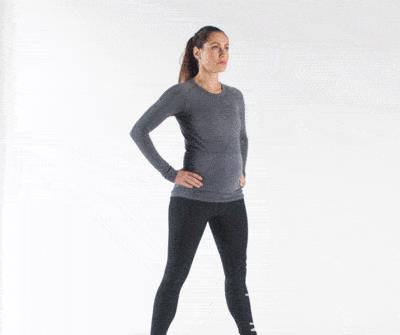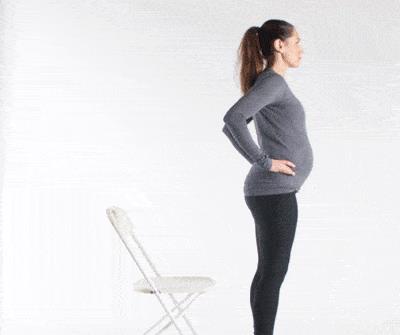Squatting at home during pregnancy is not only a form of active exercise, but it also has beneficial effects in labor and childbirth.
There are many ways to stimulate labor for pregnant women. These could be natural methods or medical procedures. Some pregnant mothers prefer to choose squats at home because they believe that this form of movement is good for the birth process. So is this thinking correct or not? Let's learn with aFamilyToday Health through the following article.
5 benefits when pregnant women squat at home
Although not necessarily a perfect method, but practicing squat at home will greatly help the labor process of pregnant mothers. Many experts recommend exercise because they find positive results related to squats and induction of labor, such as:
1. Improve pelvic pushability
Squatting is a natural position for people to expand and relax the groin muscles. The American Pregnancy Association claims that squatting can help improve pelvic pushability by up to 10%. Therefore, you should consider doing squats at home to support the body to push the baby out in the most gentle way during normal birth.
2. Strengthen leg muscles
Squatting at home with a squatting position will strengthen the calf of pregnant mother, support you to walk more steadily in the 3rd trimester and until labor.
3. Shorten labor time to give birth
Experts believe that the squatting position also helps reduce labor time down quite a lot. This can become good news for many pregnant mothers because every minute of the journey to land seems to be endless.
4. Limit constipation during pregnancy
Constipation during pregnancy is a fairly common symptom of pregnancy , leaving many women tired, even exhausted. In addition to improving with a high-fiber diet, consider practicing squat at home, as squat movements will promote a smoother "go heavy" activity.
5. Create space for the fetus
Squat also helps to create more space in the uterus so that the baby can move to the birth canal by rotating the fetus in the correct position .
Squat exercises at home for pregnant mothers to support labor
Although it offers many practical benefits, it is important for pregnant women to understand that squatting properly so that you have the right posture and do not injure yourself. In addition, pregnant mothers can practice some safe exercises during pregnancy such as:
1. Squatting exercises

This exercise is quite common and easy to do. The practice is as follows:
Stand upright, feet hip-width apart
Bring your hands out first
Imagine sitting down in a chair, slowly lowering your body until your hips are parallel to the floor
Straighten your back and try to keep your balance, you can ask your husband to stand by for support
Keep your heels touching the ground
Take a deep breath, using your leg muscles to return to starting standing
Repeat as many times as you can in your body.
2. Sumo exercise

This squat exercise targets the inner muscles of the thighs and glutes. At the same time, the hips will follow that stretch. How to do the sumo exercise as follows:
Step sideways so that the distance between your feet is wider than your shoulders and your toes are facing out, the direction of your knees in the same direction as your toes
Hands on the side
Lower yourself down to a squatting position, keep your back straight while performing. The body weight will now be pushed down to the lower body
Always point toes out, knees should not touch
Return to starting position, tightening glutes as you slowly straighten up
Repeat 10 - 15 times.
3. Squat exercises with a chair

This exercise is a great suggestion for pregnant women who lose balance during pregnancy, or are uncomfortable with traditional squat movements:
Stand 1 foot away from chair, 2 feet shoulder width apart
Hands on hips
Sit in the chair, gently rest your butt on the chair for 1-2 seconds
Squeeze your glutes while slowly standing up
Repeat 10 - 15 times.
Other exercises to support labor
In addition to doing squat at home, you can refer to some forms of movement to help the process of passing quickly and easily:
Walking: Walking helps a lot during pregnancy. This is not only an easy form of movement, but also very convenient. In addition, walking can stimulate the baby to move to the lower part of the uterus, dilate the cervix and induce labor.
Kegel: Kegel exercises affect the pelvic floor muscles, the most important organ in childbirth. If you do Kegel exercises for 10 minutes 2-3 times a day, the muscles will become stronger, thereby helping to give birth smoothly.
Climb the stairs: While you can avoid using the stairs for most of your pregnancy, it can be quite helpful when the birthing phase approaches. Taking the stairs slowly and carefully can stimulate the pelvis to open, causing the cervix to dilate, pushing the baby down the birth canal, and spontaneous labor.
Be careful when doing squats at home
Some things to keep in mind while doing squats for the safety of yourself and your baby include:
Drink a lot of water
Only practice in a flat place
Priority is given to clothes that are comfortable and absorb sweat well
Listen to your body, don't overdo it
Do not keep the knees together to prevent injury
Choose healthy foods to keep you energetic.
During pregnancy, squats are an ideal exercise to maintain strength and range of motion in your hips, buttocks, core, and pelvic floor muscles. If done correctly, squat will help pregnant mother improve posture, support the birth process.














